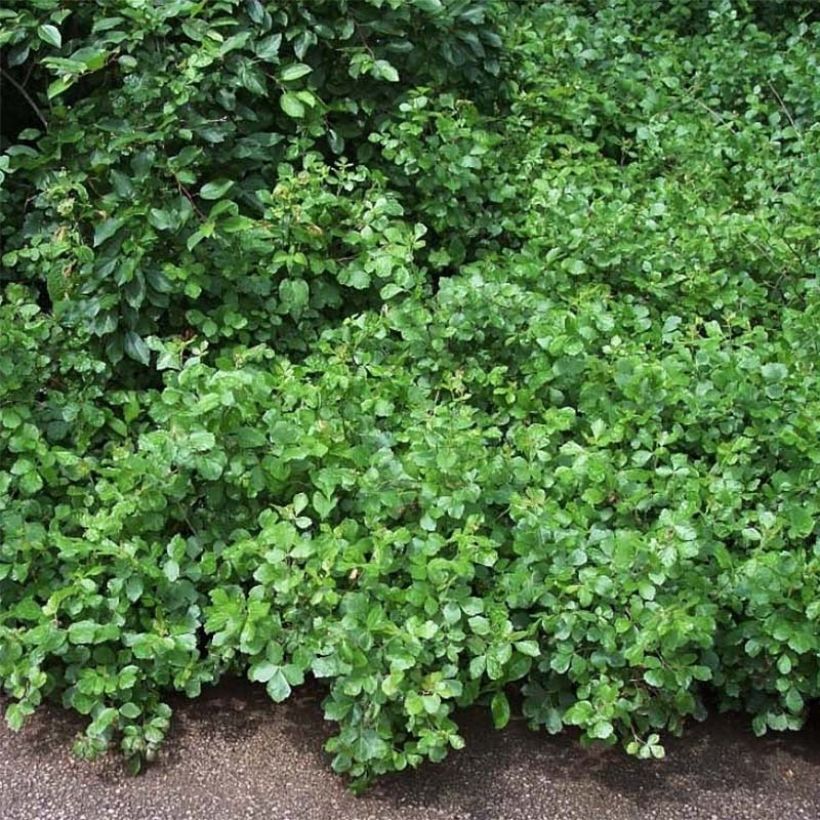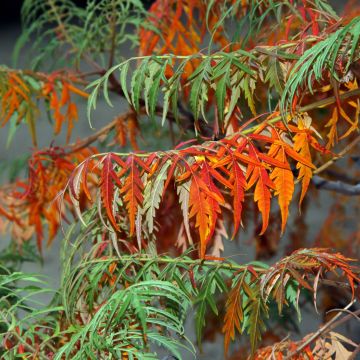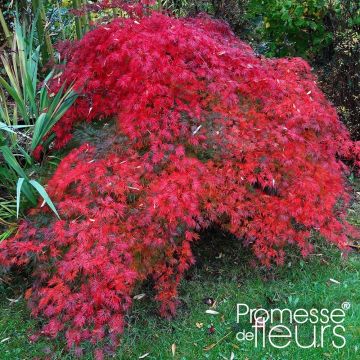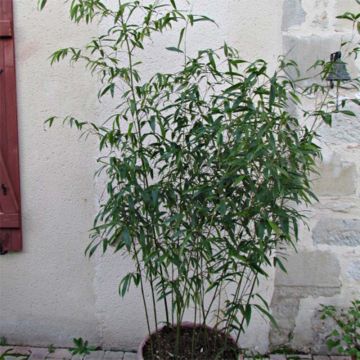

Rhus aromatica Gro-Low - Fragrant Sumach


Rhus aromatica Gro-Low - Fragrant Sumach
Rhus aromatica Gro-Low - Fragrant Sumach
Rhus aromatica Gro-Low®
Fragrant Sumach
Young plant arrived in good condition, without foliage. Waiting for establishment.
Emmanuelle, 08/11/2022
Special offer!
Receive a €20 voucher for any order over €90 (excluding delivery costs, credit notes, and plastic-free options)!
1- Add your favorite plants to your cart.
2- Once you have reached €90, confirm your order (you can even choose the delivery date!).
3- As soon as your order is shipped, you will receive an email containing your voucher code, valid for 3 months (90 days).
Your voucher is unique and can only be used once, for any order with a minimum value of €20, excluding delivery costs.
Can be combined with other current offers, non-divisible and non-refundable.
Home or relay delivery (depending on size and destination)
Schedule delivery date,
and select date in basket
This plant carries a 24 months recovery warranty
More information
We guarantee the quality of our plants for a full growing cycle, and will replace at our expense any plant that fails to recover under normal climatic and planting conditions.

Would this plant suit my garden?
Set up your Plantfit profile →
Description
Rhus aromatica 'Gro-Low'® is a recent variety of Aromatic Sumac, an aromatic suckering bush in all its parts, little known to amateur gardeners but praised by landscaping professionals for its great ease of cultivation and its autumn foliage. 'Gro-Low' has been selected for its slow growth, its very dense habit and its quite fantastic autumn colours. On this plant, small yellow flowers appear from early spring, followed by pretty red and velvety berries. They accompany a flamboyant foliage at the end of the season, and often persist on the branches throughout winter. Hardy, capable of adapting to almost any situation, extremely resistant and versatile, 'Gro-Low'® is perfect for greening natural or difficult areas of the garden, in most of our regions.
The Aromatic Sumac 'Gro-Low'® belongs to the Anacardiaceae family, just like Cotinus and pistachio trees. It comes from Rhus aromatica, native to the eastern United States. In its natural habitat, this suckering shrub spreads in the clear undergrowth that covers highlands, meadows and heathlands, as well as between rocks on cliffs. Extremely hardy, it tolerates any well-drained soil, slightly acidic, neutral or even limestone (pH 6 to 8.5), and a sunny to semi-shaded exposure. Once established, it tolerates rather well dry soils in summer.
This shrub has a slow growth and its adult size will not exceed 50 to 60cm (19.7 to 23.6in) in height, but it spreads over 2.5m (8ft 2in) in width. With a spreading and rounded habit, it develops a ramified and dense vegetation, with long ascending and then trailing stems. Its deciduous foliage is composed of leaves divided into 3 leaflets, shiny green, toothed on the edges, pubescent and lighter on the underside. They emit, just like the branches, a citrus aroma when crushed or bruised. They emerge brown-red in spring, then turn green, and finally orange and then red to purple-violet at the end of the season. In this Sumac, there are male and female plants, as well as hermaphroditic individuals, which are rarer. The flowering begins in autumn on the branches. The male flowers are arranged in long catkins, while the female flowers are grouped in short terminal panicles. The flowers bloom in March-April, before the leaves appear. They are fragrant and yellow. The flowering is followed in summer on the female or hermaphroditic plants by red, velvety drupes gathered in tight clusters. If not consumed by birds and some small mammals, they can persist until the heart of winter.
Plant Rhus 'Gro-Low'® along a pathway, a fence wall, to border a rockery or to dress an unattractive slope that it will stabilize. Forming a dense mass with remarkable autumn colours, it excels in difficult areas to cover, in poor soil or in slightly wild corners of the garden, for example under a small grove composed of 3 to 5 deciduous small trees. It can also be used in front of low hedges where compact Forsythias, broom Genistas, hedge honeysuckles or Tartarian honeysuckles, creeping Cotoneasters and Berberis mix. For flamboyant backgrounds, it can be associated with European spindle trees, Persian ironwoods, smoke trees or castor oil plants.
Unlike its cousin Rhus radicans, Aromatic Sumac is not toxic to humans. On the contrary, its leaves and fruits can be dried and used in infusions. It is used in homeopathy, particularly in dermatology. Birds are fond of its fruits.
Report an error about the product description
Rhus aromatica Gro-Low - Fragrant Sumach in pictures




Plant habit
Flowering
Foliage
Botanical data
Rhus
aromatica
Gro-Low®
Anacardiaceae
Fragrant Sumach
Cultivar or hybrid
Other Rhus - Sumac
View all →Planting and care
Plant Rhus aromatica 'Gro-Low'® in any soil, even chalky and poor, stony, dry or moist but well-drained. It will thrive in partial shade or in the sun, but it is commonly accepted that the autumn colours will be more intense with a sunny exposure, the bush needing at least six hours of direct sunlight per day. A sheltered position away from the wind is preferable to preserve the foliage. As it produces suckers and sometimes roots naturally, it is useful to monitor the appearance of unwanted shoots and eliminate them without difficulty. The root system of this Rhus is spread out on the surface but shallow: it can be transplanted very easily. It can sometimes be affected by diseases such as rust or may have foliar spots, generally without dramatic consequences for the plant. Aphids and scale insects can also affect it depending on the growing conditions.
Planting period
Intended location
Care
-
, onOrder confirmed
Reply from on Promesse de fleurs
Similar products
Haven't found what you were looking for?
Hardiness is the lowest winter temperature a plant can endure without suffering serious damage or even dying. However, hardiness is affected by location (a sheltered area, such as a patio), protection (winter cover) and soil type (hardiness is improved by well-drained soil).

Photo Sharing Terms & Conditions
In order to encourage gardeners to interact and share their experiences, Promesse de fleurs offers various media enabling content to be uploaded onto its Site - in particular via the ‘Photo sharing’ module.
The User agrees to refrain from:
- Posting any content that is illegal, prejudicial, insulting, racist, inciteful to hatred, revisionist, contrary to public decency, that infringes on privacy or on the privacy rights of third parties, in particular the publicity rights of persons and goods, intellectual property rights, or the right to privacy.
- Submitting content on behalf of a third party;
- Impersonate the identity of a third party and/or publish any personal information about a third party;
In general, the User undertakes to refrain from any unethical behaviour.
All Content (in particular text, comments, files, images, photos, videos, creative works, etc.), which may be subject to property or intellectual property rights, image or other private rights, shall remain the property of the User, subject to the limited rights granted by the terms of the licence granted by Promesse de fleurs as stated below. Users are at liberty to publish or not to publish such Content on the Site, notably via the ‘Photo Sharing’ facility, and accept that this Content shall be made public and freely accessible, notably on the Internet.
Users further acknowledge, undertake to have ,and guarantee that they hold all necessary rights and permissions to publish such material on the Site, in particular with regard to the legislation in force pertaining to any privacy, property, intellectual property, image, or contractual rights, or rights of any other nature. By publishing such Content on the Site, Users acknowledge accepting full liability as publishers of the Content within the meaning of the law, and grant Promesse de fleurs, free of charge, an inclusive, worldwide licence for the said Content for the entire duration of its publication, including all reproduction, representation, up/downloading, displaying, performing, transmission, and storage rights.
Users also grant permission for their name to be linked to the Content and accept that this link may not always be made available.
By engaging in posting material, Users consent to their Content becoming automatically accessible on the Internet, in particular on other sites and/or blogs and/or web pages of the Promesse de fleurs site, including in particular social pages and the Promesse de fleurs catalogue.
Users may secure the removal of entrusted content free of charge by issuing a simple request via our contact form.
The flowering period indicated on our website applies to countries and regions located in USDA zone 8 (France, the United Kingdom, Ireland, the Netherlands, etc.)
It will vary according to where you live:
- In zones 9 to 10 (Italy, Spain, Greece, etc.), flowering will occur about 2 to 4 weeks earlier.
- In zones 6 to 7 (Germany, Poland, Slovenia, and lower mountainous regions), flowering will be delayed by 2 to 3 weeks.
- In zone 5 (Central Europe, Scandinavia), blooming will be delayed by 3 to 5 weeks.
In temperate climates, pruning of spring-flowering shrubs (forsythia, spireas, etc.) should be done just after flowering.
Pruning of summer-flowering shrubs (Indian Lilac, Perovskia, etc.) can be done in winter or spring.
In cold regions as well as with frost-sensitive plants, avoid pruning too early when severe frosts may still occur.
The planting period indicated on our website applies to countries and regions located in USDA zone 8 (France, United Kingdom, Ireland, Netherlands).
It will vary according to where you live:
- In Mediterranean zones (Marseille, Madrid, Milan, etc.), autumn and winter are the best planting periods.
- In continental zones (Strasbourg, Munich, Vienna, etc.), delay planting by 2 to 3 weeks in spring and bring it forward by 2 to 4 weeks in autumn.
- In mountainous regions (the Alps, Pyrenees, Carpathians, etc.), it is best to plant in late spring (May-June) or late summer (August-September).
The harvesting period indicated on our website applies to countries and regions in USDA zone 8 (France, England, Ireland, the Netherlands).
In colder areas (Scandinavia, Poland, Austria...) fruit and vegetable harvests are likely to be delayed by 3-4 weeks.
In warmer areas (Italy, Spain, Greece, etc.), harvesting will probably take place earlier, depending on weather conditions.
The sowing periods indicated on our website apply to countries and regions within USDA Zone 8 (France, UK, Ireland, Netherlands).
In colder areas (Scandinavia, Poland, Austria...), delay any outdoor sowing by 3-4 weeks, or sow under glass.
In warmer climes (Italy, Spain, Greece, etc.), bring outdoor sowing forward by a few weeks.











































